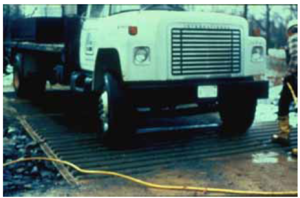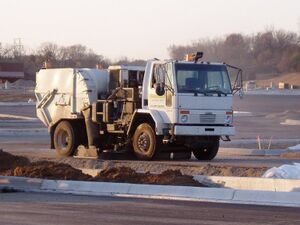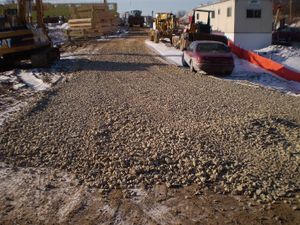
Difference between revisions of "Construction stormwater best management practice – Vehicle Tracking"
PKalinosky (talk | contribs) |
|||
| (8 intermediate revisions by 2 users not shown) | |||
| Line 36: | Line 36: | ||
==Cold climate considerations== | ==Cold climate considerations== | ||
| − | + | [[File:Street_sweeping.jpg |right|thumb|300 px|alt=This photo shows Street sweeping is required to remove any sediment that is tracked onto the street.|<font size=3>Street sweeping is required to remove any sediment that is tracked onto the street.</font size>]] | |
| − | [[File: | ||
Vehicles leaving a construction site during the winter months can track sediment and sediment-laden snow from the site onto adjacent roadways. It is important to remember that all construction sites must remain in compliance with the NPDES/SDS permit throughout the winter even if no construction is occurring; therefore a well maintained and functioning vehicle tracking pad must be in place. Regular inspection of vehicle tracking pads must continue throughout the winter months and regular maintenance will be needed during the spring thaw. As with the summer months, additional aggregate should be readily available for top dressing and maintenance of the pad throughout winter. | Vehicles leaving a construction site during the winter months can track sediment and sediment-laden snow from the site onto adjacent roadways. It is important to remember that all construction sites must remain in compliance with the NPDES/SDS permit throughout the winter even if no construction is occurring; therefore a well maintained and functioning vehicle tracking pad must be in place. Regular inspection of vehicle tracking pads must continue throughout the winter months and regular maintenance will be needed during the spring thaw. As with the summer months, additional aggregate should be readily available for top dressing and maintenance of the pad throughout winter. | ||
| Line 43: | Line 42: | ||
A combination of plowing and street sweeping may be necessary to ensure mud does not remain on the paved streets. Special attention should be paid to promptly remove all sediment and sediment laden snow and ice on the roadways prior to the spring melt. | A combination of plowing and street sweeping may be necessary to ensure mud does not remain on the paved streets. Special attention should be paid to promptly remove all sediment and sediment laden snow and ice on the roadways prior to the spring melt. | ||
| − | [[File:Aggregate.jpg | | + | [[File:Aggregate.jpg |left|thumb|300 px|alt=This photo shows Add additional aggregate regularly to maintain a vehicle-tracking pad.|<font size=3>Add additional aggregate regularly to maintain a vehicle-tracking pad.</font size>]] |
| + | |||
| + | [[Category:Level 3 - Best management practices/Construction practices/Sediment control practices]] | ||
| + | |||
| + | ==Resources== | ||
| + | *[https://metrocouncil.org/Wastewater-Water/Planning/Water-Resources-Management/Water-Quality-Management-Key-Roles.aspx Metropolitan Council Urban Small Sites Best Management Practice Manual] | ||
| + | *[https://www.dot.state.mn.us/products/ Minnesota Department of Transportation (Mn/DOT) Approved Products List] | ||
| + | *[http://www.pca.state.mn.us/water/pubs/sw-bmpmanual.html MPCA Protecting Water Quality in Urban Areas – Manual] | ||
| + | *[http://www.pca.state.mn.us/publications/wq-strm2-10.pdf MPCA Stormwater Construction Inspection Guide] | ||
| + | *[https://www.epa.gov/npdes/national-menu-best-management-practices-bmps-stormwater#edu USEPA National Pollutant Discharge Elimination System (NPDES) Menu of BMPs] | ||
| + | <noinclude> | ||
| + | [[Category:Level 3 - Best management practices/Construction practices/Fact or summary sheet]] | ||
| + | </noinclude> | ||
Latest revision as of 17:10, 19 August 2024
Vehicles leaving construction sites track sediment onto adjoining road ways. This sediment can create serious safety hazards as well as contribute significantly to sediment pollution problems in waterways. Through the use of vehicle tracking pads and street sweeping, the amount of sediment and other pollutants leaving the construction site is limited and the amount of sediment discharged to surface water is decreased.
Contents
What is required by the NPDES/SDS construction stormwater permit?
The NPDES/SDS Construction Stormwater Permit states that the tracking of sediment from a construction site onto roadways must be minimized with appropriate best management practices (BMPs) such as stone pads, concrete or steel wash racks or equivalent systems. If these BMPs are not adequate in preventing sediment tracking, street sweeping is required. The permit states that all external washing of vehicles must be limited to a defined area and runoff must be contained to prevent transport of sediment offsite.
Construction site vehicle exit locations must be inspected for sediment tracked onto paved surfaces. Sediment tracked off-site must be removed within 24 hours of discovery to prevent it from being washed away by stormwater and to avoid a safety hazard. It is important to note that the permit requires street sweeping to remove sediment tracked to the street, but it is NOT an alternative to having a vehicle tracking pad. First work to minimize mud and sediment tracked from the site and follow up with sweeping to collect material that has left the site. For full details of the permit requirements, click here.
What is a vehicle tracking pad?
A vehicle tracking pad is typically a stabilized pad of aggregate over a geotextile base installed at every vehicle exit utilized by construction traffic. It is designed in a way that when vehicles drive over the pad, the tires sink into the rock slightly and mud is removed. Generally the aggregate used is 1.5 to 3 inches in size and placed in a layer approximately 6 inches thick. However, the MPCA staff has observed that vehicle tracking pads consisting of coarser aggregate materials (2 to 6 inches) are often more effective in many applications. The vehicle tracking pad should be at least 50 ft long but longer pads may be required to adequately clean tires. The amount of construction traffic and frequency of use should be considered when designing a vehicle tracking pad.
Alternative materials such as wood chip pads can be used as vehicle tracking pads as well. These materials are effective in preventing mud from sticking to tires, but less effective than aggregate at removing mud from tires. In addition commercial products are available for use as vehicle tracking pads. See Resources at the end of this factsheet for a link to the Minnesota Department of Transportation’s list of approved products.
In many cases the action of the tires moving over the aggregate pad may not adequately remove sediment from the tires. In these cases the tires may need to be washed before the vehicle leaves the site. A wash rack can be installed on the aggregate pad and generally consists of a prefabricated rack such as a cattle guard. It is important to remember that the type of rack used must support the size of the vehicles crossing it. Wash water should be directed to a suitable settling area to be treated and/or recycled.
A vehicle tracking pad should be at least 50 feet in length but may need to be longer to adequately remove sediment from vehicle tires.
How effective is a vehicle tracking pad?
A vehicle tracking pad can be very effective if it is designed, installed, and maintained properly. In order to effectively prevent sediment from leaving the site on vehicle tires, vehicle tracking pads should be installed prior to any land disturbing activity and all construction traffic should be limited to exiting the site through these designated locations. When planning the most effective vehicle tracking pad, the following should be taken into account:
- Underlying soils on site
- Frequency of use
- Length and width of the entrance
- Depth of rock
- Size and type of vehicles
- Frequency of maintenance
It is important to take into consideration the exact situation where the vehicle tracking pad will be used. Simple, sometimes inexpensive changes or additions to the vehicle tracking pad can make it more effective and prevent costly permit violations.
Maintenance considerations
Vehicle tracking pads require constant maintenance especially during and after rain events to effectively prevent tracking of sediment onto paved roads. All vehicle tracking pads should be inspected at a minimum daily and more often when the potential for soil tracking is present. A newly installed pad is the most efficient at removing mud and sediment from vehicles. After extended use and/or heavy rainfall events, the pad can become clogged with mud and no longer work effectively. Rock or wood chips should always be on hand at the construction site for additional top dressing, removal and reinstallation of the pad. If temporary paving is used as the vehicle tracking pad, regular sweeping is needed to clear away sediment. For sites utilizing a wash station, the area established to collect the wash water should be regularly inspected and cleaned out to ensure sediment is contained properly and water is treated or recycled. Street sweeping equipment should be readily available to clean sediment from paved surfaces regularly.
Cold climate considerations
Vehicles leaving a construction site during the winter months can track sediment and sediment-laden snow from the site onto adjacent roadways. It is important to remember that all construction sites must remain in compliance with the NPDES/SDS permit throughout the winter even if no construction is occurring; therefore a well maintained and functioning vehicle tracking pad must be in place. Regular inspection of vehicle tracking pads must continue throughout the winter months and regular maintenance will be needed during the spring thaw. As with the summer months, additional aggregate should be readily available for top dressing and maintenance of the pad throughout winter.
A combination of plowing and street sweeping may be necessary to ensure mud does not remain on the paved streets. Special attention should be paid to promptly remove all sediment and sediment laden snow and ice on the roadways prior to the spring melt.
Resources
- Metropolitan Council Urban Small Sites Best Management Practice Manual
- Minnesota Department of Transportation (Mn/DOT) Approved Products List
- MPCA Protecting Water Quality in Urban Areas – Manual
- MPCA Stormwater Construction Inspection Guide
- USEPA National Pollutant Discharge Elimination System (NPDES) Menu of BMPs
This page was last edited on 19 August 2024, at 17:10.


